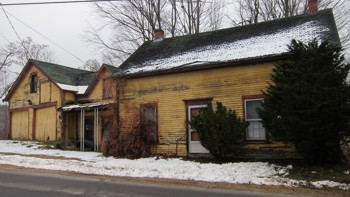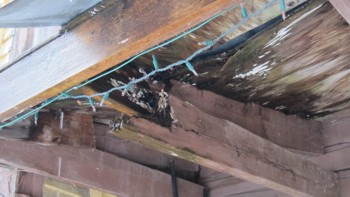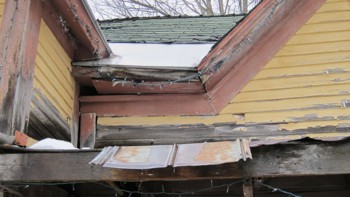Water Damage Tips
DEAR TIM: I was at a party this weekend and of all the crazy things to talk about, a discussion started about what's the biggest danger to a house falling down. Wind, poor soil, bad foundation, poor construction, ultraviolet light, etc. were all debated heavily. I so wish you would have been there to settle the debate. What, in your opinion, is the biggest danger to a house? Can you give examples and then offer solutions? Mike C., Bar Harbor, ME
DEAR MIKE: The answer was right there in front of all of you! After all, you live immediately adjacent to the ocean there in Bar Harbor! Had I been invited to the party, and mind you I would have driven from New Hampshire to get there, I would have done my best to convince the crowd it's just one thing: water.

This house is succumbing to the methodical attack by rain water. The water will win in the end unless the wood surfaces are maintained. PHOTO CREDIT: Tim Carter
If houses could talk, and in a way they do when they finally collapse, they'd be screeching like the Wicked Witch of the West did when doused with water at the end of the L. Frank Baum's children's book The Wonderful Wizard of Oz.
I realize we can't go back in time and talk with the builders thousands of years ago, but the circumstantial evidence they left for us all around us screams that they knew that the strongest building material is stone. Look at all the great buildings that are still standing after thousands of years. They have one thing in common - stone.
And granite is perhaps the most durable of all. These wise builders knew that water quickly caused wood to rot. They realized that if they wanted to build something that might last thousands of years, they had to use stone.
But even stone is not immune to destruction by both wind and water. All you have to do is visit the Grand Canyon to see what ever patient water can do when combined with gravity. Look at how wind and water are eroding the great Sphinx.
Here in the USA, we still build primarily with wood because it's very cheap when you consider the other options. But the wood we use today in no way resembles the wood taken from the forests 200 years ago. Many of the old growth trees that were felled by our ancestors had much tighter growth rings. In these trees, the summer wood that's much denser and far more resistant to rot made up a much larger percentage of the wood in the tree than the framing lumber you and I can purchase at a lumber yard.
When water saturates wood, it's the fuel to start wood rot. If allowed to continue, as you see happen in abandoned homes or ones that are occupied and neglected, the house, or parts of it, will collapse.
Water will blast apart masonry chimneys over time, it will do the same with rock foundations, and it absolutely will conquer poured concrete given enough time. Add in some freezing weather to this recipe, and the destruction of brick, concrete, stone, etc. is accelerated from the expansion of the water that seeps into micro cracks and then freezes.
Water will attack and corrode steel or iron in a house. Think of how steel is used to support primary structural elements in a home and how thousands of uncoated steel nails are used to connect critical pieces of wood framing. Water laughs at the thin electro-galvanized coating on certain nails used in residential construction. In just decades, it can wear through this and attack the steel core. This is why double hot-dipped galvanized nails are better, and stainless steel fasteners are the best.
Look back at the builders of old and you'll discover they knew all of this. They used simple felt paper to cover the wood framing of houses to keep them dry. The masons of old knew to use mortars that contained lots of hydrated lime in them, as this material would work over time to actually heal tiny hairline cracks in the mortar where water would try to enter.
The roofers of old knew to use 40-pound tin coated steel or copper for roof flashings. These materials could last well over one hundred years and could be soldered to prevent water from touching the wood. These same roofers knew that using stone as a roofing material, slate, would help slow down water's relentless attacks.
The sad thing is that much of the hard-earned knowledge of the older builders is being lost. All of their knowledge can be found in many older homes. You just have to look for it.
You'll see they knew all about stone, slate, copper flashings, heavy felt paper, etc. They also figured out that generous roof overhangs would help keep water away from houses just as we use an umbrella in a rain shower.
The older builders also knew all about the surface tension of water. Who would think that would be something you'd have to worry about? But that's why masonry and wood window sills had a kerf channel cut into them on the front edge of the underside of the sill. This channel causes the water to stop and turn into a droplet that falls to the ground instead of clawing its way under the sill towards the wall face.
I feel there's an abundant amount of evidence that proves that water is the primary foe of a house, and that the long lost builders knew it and tried their best to educate us.

Severe wood rot has decimated the roof rafter and the plywood roof sheathing. You can see the white wood fungus growing on the underside of the plywood.

Wood rot is causing the center portion of the house to collapse and pull away from the left section. This is what's causing the giant opening just below the roof overhang.
Column 911